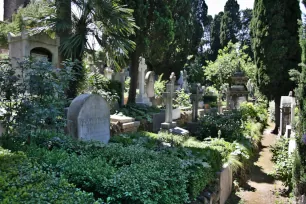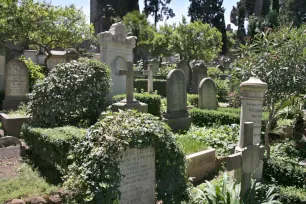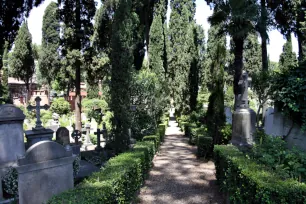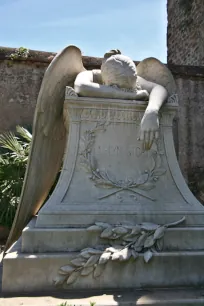In the shadow of the monumental Pyramid of Caius Cestius is the romantic Protestant Cemetery, a private cemetery where you find the graves of many famous and less-famous non-Catholics.



The cemetery is located just inside the Aurelian Wall on a beautiful sloping site planted with cypresses and pine trees.
The official name of the cemetery is ‘Non-Catholic Cemetery for Foreigners at Testaccio’, but it is commonly known as the Protestant Cemetery, since many of the people buried here are either German or English. But there are also graves from other nationalities, including Russians, Greek, Danish and Swedish. It’s not just foreigners who lie buried here either: Italian atheists, including Antonio Gramsci, co-founder of the Italian Communist Party, are also buried here.
Some of the most notable graves are those of the English poet John Keats, his colleague and compatriot Percy Bysshe Shelley, the sons of Wilhelm von Humboldt and the son of Johann Wolfgang von Goethe.
History
Non-Catholics cannot be buried in Catholic churches or cemeteries, and the bodies of foreigners who died in Rome were often thrown into the Tiber river. In 1716 Pope Clement XI allowed members of the exiled House of Stuart to be buried near the Pyramid of Caius Cestius.
The oldest recorded burial on this site however dates from 1732. And from 1738 on it became a more common practice to bury non-Catholics here. In 1821 Pope Pius VII decided that there should be no more burials so close to the pyramid and an adjacent plot was designated for the burial of foreigners. It’s around this time that the site became the official cemetery for non-Catholics in Rome. The cemetery was further enlarged, the last time in 1898, when it got its current form.
Notable Graves

Rome was an inspiration for many painters, sculptors, writers and other artists. As a result, you find many graves of artists from around Europe and the United States. Rome also attracted many historians, several of whom are buried here, as well as diplomats who had often lived here for decades.
The cemetery is divided into two sections. The oldest one, near the Pyramid of Caius Cestius, is only sparsely sprinkled with graves. The rest of the cemetery is divided into four zones and laid out on a terrain that slopes upward toward the Aurelian Wall. This area is much denser, crammed with numerous graves and monuments vying for attention.
In the old section, called the Parte Antica, you find the grave of John Keats, probably the most visited grave in the cemetery. Keats is considered one of the most important poets of his generation. In 1820, on the suggestion of Joseph Severn, he moved to Rome for health reasons. Keats died the following year from Tuberculosis at the young age of twenty-five. Inscribed on his grave are the words he had written on his deathbed: “Here lies One Whose Name was writ in Water”. In 1882 his close friend Joseph Severn, a painter, was buried next to Keats.

Also in the Parte Antica are the graves of the sons of Wilhelm von Humboldt, a Prussian statesman and founder of the Humboldt University. His sons died in 1803 and 1807 aged nine and two, while he lived in Rome as consul.
The grave of August von Goethe, son of the famous German poet, can also be found here. It is decorated with a relief portrait created by Bertel Thorvaldsen. The elder Goethe, who survived his son by two years, also wanted to be buried here. Instead, his grave is in Weimar, in his native country.
Another popular grave is that of the English poet Percy Bysshe Shelley, who drowned in 1822 off the Italian coast. He considered the Protestant Cemetery the most beautiful cemetery he had ever seen and wanted to be buried here. His heart was transferred back to England; ironic since his grave is inscribed with the words «Cor cordium» (the heart of hearts).
The German architect Gottfried Semper is also buried here. Semper, who gained fame with his design of the Opera House in Dresden, was forced to flee his hometown after he participated in a failed revolt. After suffering health problems he travelled to Italy where he died in 1879.
Other notable figures buried at the Protestant Cemetery include the Russian painter Karl Pavlovich Brullov; the American sculptor William Wetmore Story, who created «Angel of Grief» – the cemetery’s most beautiful sculpture – for the grave of his wife; and the American poet Gregory Corso, one of the most influential members of the Beat Generation.
- Next: Sant'Ignazio
- More Sights & Attractions in Rome

